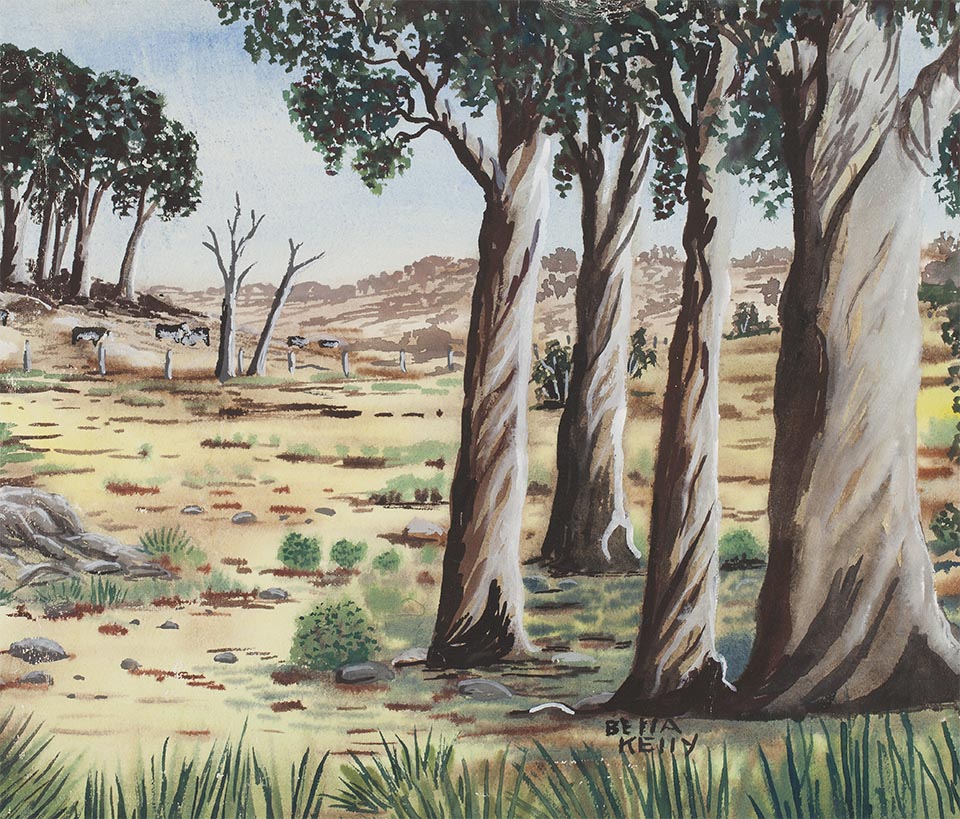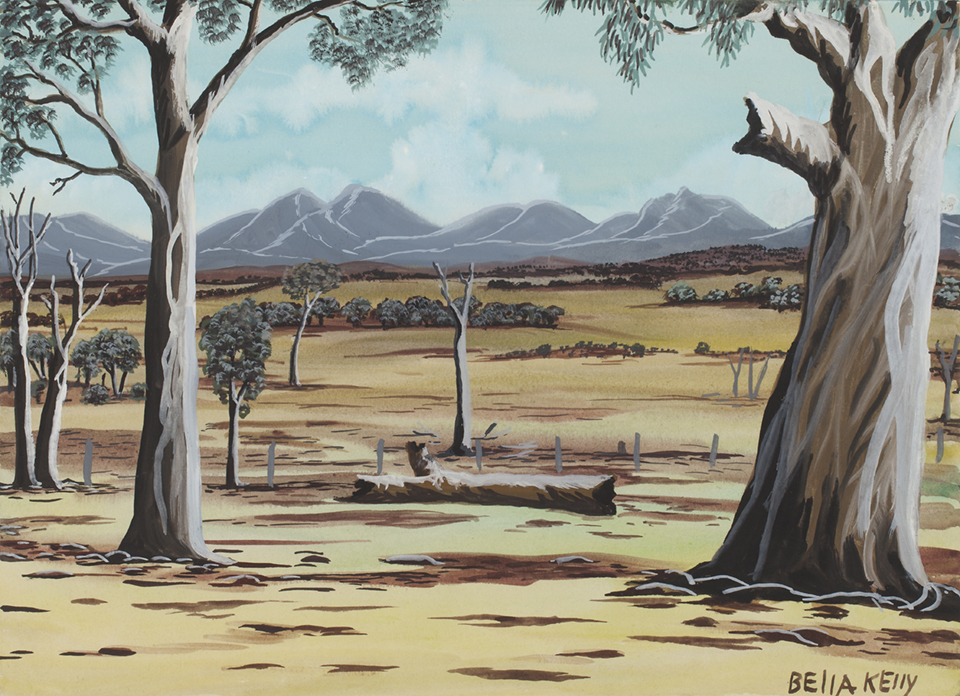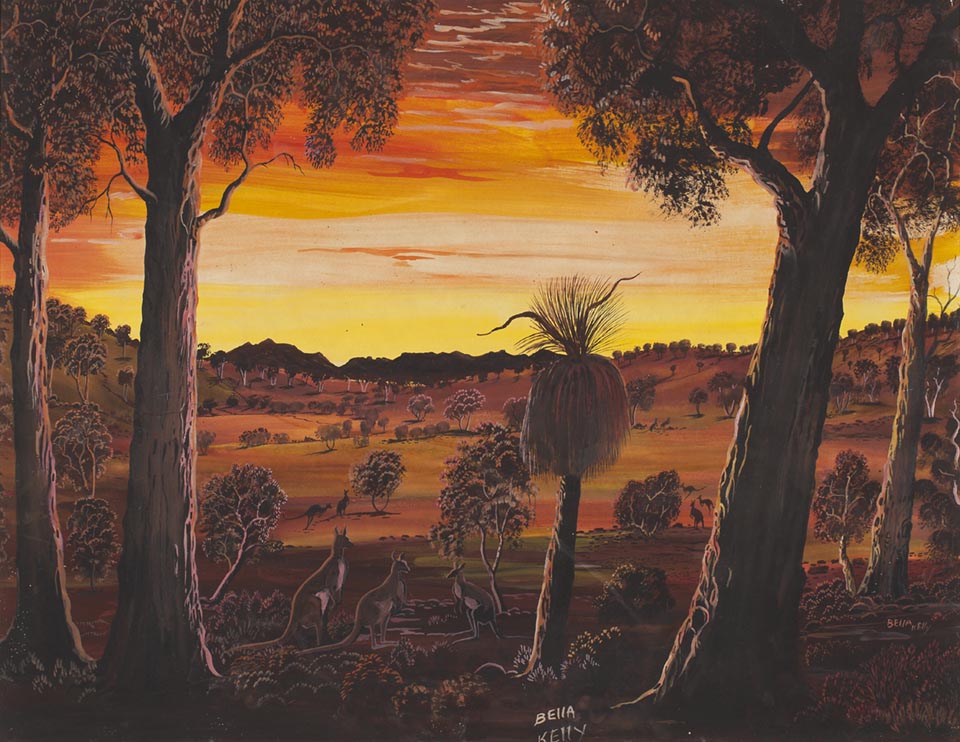The Art & Influence of Bella Kelly
Annette Davis, from the City of Albany’s Vancouver Arts Centre is the curator of the Bella Kelly Retrospective, a project supported by the Departments of Culture and the Arts and Regional Development, Royalties for Regions and Country Arts WA. In this interview Annette talks about the artist and her place in history. She discusses the proposal that Bella Kelly influenced the development of the distinctive Carrolup style.
Where did the artist Bella Kelly come from?
Bella Kelly was born in Mount Barker which is in the south-west of Western Australia. Mount Barker is actually within the region that’s also known as the Great Southern. The main town centre in that region is Albany. It’s on the south coast about four hundred kilometres south of Perth. Bella Kelly was born in Mt Barker in 1915. She lived throughout that region during her life until she passed away in 1994.
Can you tell me about her art?
Bella Kelly painted landscape paintings of the Great Southern. The majority of her paintings have in the background the Stirling Ranges. It is a long and high mountain range in the Great Southern. Bluff Knoll is the highest peak in that mountain range. The Stirling Ranges were important to Bella and they feature in the majority of her paintings. She moved through several little towns throughout the Great Southern. She lived with various family members during her life. The paintings are about the country that she was living in.

Can you tell me about the life of an indigenous Australian at that time in Australia’s history?
Yes. The 1905 Aborigines Act put a huge number of restrictions on Aboriginal people. From the 1920s on most Aboriginal people lived on missions or reserves on the outskirts of towns. The only work options were basic farm labouring type work or domestic work. This included laundry work and child minding. Bella grew up on a farm just near Mount Barker owned by Egerton-Warburton family. By the time she was about 13 or 14 she was working as a domestic in houses throughout the Great Southern. She helped with cooking, cleaning and looking after children.
Aboriginal people were given food rations. Anyone under the age of 18 was a ward of the State. The commissioner of native affairs had total control over where that person should be. During that period many children were taken away from their families. Bella gave birth to four boys in the 1930s. They were all taken away from her in the 1940s. In the 1950s Bella had a second family of four children. They were also taken away and sent to Wandering Mission.
Bella Kelly endured the real harsh end of that legislation and the government policies. Her painting, the activity of painting gave her a lot of emotional solace. It also became an important source of income for her. She relied, and her family relied, on her painting. She sold her paintings to get money to get the basic provisions for their family.
How did she come to be painting, how was that introduced into her life?
It seems that she had an innate talent. As a young girl on the Egerton-Warburton farm she saw pictures of English landscapes. She was shown these pictures by her friend Kitty Egerton-Warburton. It seems that Bella had a remarkable memory and a remarkable ability to copy. She had an innate interest and talent for drawing. There are many anecdotes of her as a young woman drawing round the campfire. She would be drawing with a stick in the sand, or drawing with charcoal on paper bark. Sometimes she’d draw on the back of a burnt frying pan using a stick to actually incise into that burnt surface.
All those forms of art are ephemeral. We don’t have any of those left. We haven’t been to locate any, so we’re relying on the anecdotal evidence that she was drawing from a young age. There’s also the proposal she had access to crayons because she was working in family homes.
She just had this innate talent and it seems that she was self taught. There’s also anecdotal stories of her brother Lindsey Colbung drawing as well. It seems that that inclination to draw may have come even from their father Billy Colbung. He was a farm laborer and he would draw a map in the dirt to show where he was working. This was a way that the farmers communicated to their workers where they had to go. Drawing in the sand or dirt was not an uncommon way of conveying information. It seems that Lindsey and Bella were definitely drawing at a young age.

In the work that has remained, what were the mediums that Bella was using?
She was using watercolour on paper and she painted with that for quite a long time. By the 1970s she was beginning to use acrylic on canvas boards and then acrylic on stretched canvas. She also used gouache as well with her watercolours. She used that to highlight particular aspects of the painting. Bella learnt how to use acrylic paint from her son Goldie Kelly.
How do you see her work evolving over the time that she was painting?
That’s an interesting question because the subject matter remained the same. It was the tall tree trunks framing a view through to the Stirling Ranges. Her work became more detailed and there were more elements within it. In the 1950s and 1960s she painted with quite basic materials. She was living in tents or working around the campfire. Despite the conditions she would manage to paint these clean looking watercolor paintings. They have fresh colours, and simple composition.
As she developed her style and became more confident she added in a lot more detail. She started to use more complicated layouts, particularly in the middle ground. She seemed to take great pride in putting in a lot of detail through that middle ground of a painting. You can see how she’s developing further that sense of perspective. That is something that I appreciate about her paintings.
Over what period did Bella Kelly paint?
Bella started painting in the 1940s. That’s when we’ve got the first evidence of her painting. She was given her first set of paints in the mid 1940s and from then on she seemed to be painting on paper.
When did she do her last painting?
Her daughters remember her painting up until she died in 1994.
Why are her paintings considered so significant?
Her paintings are significant for a few reasons. She was a Aboriginal woman living in difficult times. Despite the challenges she was painting and selling her paintings. Her paintings feature the country that she was living in. They convey a strong connection to country.
I think people who bought her paintings could see that. They had a connection to the country as well. She was selling within the environment in which she was painting. Her paintings are of a particular era, in some ways many of them are quite a naive style of art. She had an audience and she had people who were supporting her. That’s significant I think in that practical sense. This is a way an Aboriginal woman survived during that period.

As artworks they’re significant because they relate to the Carrolup artworks. The Carrolup art story is a huge story in itself. I propose that Bella was potentially influencing that boys that were at Carrolup. Her sons were at Carrolup. Bella also benefited from the interest in the Carrolup artworks. That interest opened up people’s eyes to what Aboriginal people could do.
By the early 1950s I think Bella could see that she could make paintings and that there was an audience for them. She could see that people would buy them. From the 1950s on she was seeing them as a way of earning some income.
We don’t know of any other Aboriginal person from that time who painted so consistently. The Carrolup artists did paint but often their opportunity to paint was limited. Bella managed to have support from different people who helped her get art materials. It was just such a crucial part of her lifestyle. To earn income she had to keep producing paintings.
Could you tell us the story about how that signature came to be?
Bella didn’t sign her early paintings. This changed in 1954 in Narrogin. Bella was in hospital having her first daughter Cheryl Narkle. She asked for paints and paper to keep painting. A nurse taught her how to write her signature on the paintings.
Bella hadn’t learned to read or write and so the signature is quite a distinctive signature. That’s a key part of identifying a painting as a Bella Kelly painting.
What have you learnt about her during this process of putting the exhibition together?
Bella was an Aboriginal woman who had suffered so much. I am amazed that she could maintain such strength and resilience. She would sell paintings in the street. She’d walk up to farmer’s houses and knock on the door and say, “Mrs, will you buy a painting?” I just find that quite incredible that she had the resilience to do that. I’m full of admiration for her.
I guess I see within her family the strength of those people. Her son Geoff Narkle was another strong leader. Cheryl and Caroline her daughters are such strong resilient people. You have to remember the isolation experienced by Aboriginal people living on reserves. People couldn’t just go onto the reserve. The only white person allowed onto a reserve was the policeman.
Interaction between indigenous and non indigenous people was limited. It was an employer employee relationship, or a welfare relationship. Bella was able to create a different relationship. She was offering a white person something that they actually wanted. It was a painting of the country that they recognised. I find that an interesting point of interaction. I’m just full of admiration for Bella for actually being able to do that.

What do you want people to understand about Bella Kelly?
Here was a woman who the system had treated harshly. She rose above that and used her amazing talent to create a life for herself and for her family. Selling the paintings became such an important thing. It became something that she could be proud of. It is something her family could be proud of. Even the people who bought the paintings are proud of. It’s a shared appreciation of their country. Often people cherished those works.
Did Bella Kelly get much recognition during her life?
During Bella’s life she did get some recognition. She was a NAIDOC Aboriginal Artist of the Year in 1988. She had a few exhibitions. In 1991 she had an exhibition at The Fremantle Art Centre along with Alma Toomath and Michelle Broun. She wasn’t unknown during her life, but since she’s passed away in 1994 I think that her story has faded.
There are several histories written about Aboriginal art. In these Bella is described as having being influenced by the Carrolup artists. From the research and anecdotal information, I see she was drawing before Carrolup artists. Her sons and other family were at Carrolup. They had seen Bella’s work. This exhibition contributes to an ongoing conversation. Where did that Carrolup style come from? It’s likely that Bella Kelly was a key influence. I think acknowledging that is an important contribution to our State’s art history.
The Bella Kelly Retrospective will be on display at the John Curtin Gallery from 20 June – 21 August 2016
References:
After the John Curtin Gallery, the exhibition will travel to the NEXIS Exhibition Space in Narrogin from September 9 to October 16.
Learn more:

